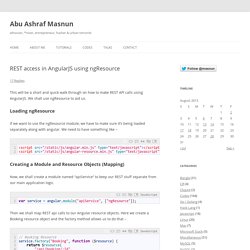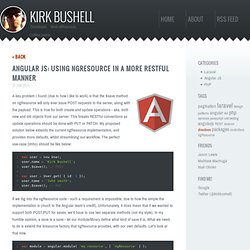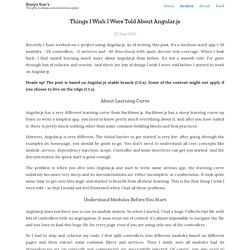

REST access in AngularJS using ngResource. This will be a short and quick walk through on how to make REST API calls using AngularJS.

We shall use ngResource to aid us. Loading ngResource If we want to use the ngResource module, we have to make sure it’s being loaded separately along with angular. We need to have something like – Angular JS: Using ngResource in a more RESTful manner. A key problem I found (due to how I like to work) is that the $save method on ngResource will only ever issue POST requests to the server, along with the payload.

This is true for both create and update operations - aka, both new and old objects from our server. This breaks RESTful conventions as update operations should be done with PUT or PATCH. My proposed solution below extends the current ngResource implementation, and provides more defaults, whilst streamlining our workflow. The perfect use-case (imho) should be like below: If we dig into the ngResource code - such a requirement is impossible, due to how the simple the implementation is (much to the Angular team’s credit).
Update: Resolved the save method not returning results - thanks bpetering! Here we’re defining a custom module - my.resource. First, we define our new defaults. Below this we’re extending the defaults with any methods you may have provided to the resource itself. Index of /1.2.11/ Building a Web App From Scratch in AngularJS. Things I Wish I Were Told About Angular.js. Recently I have worked on a project using Angular.js.

As of writing this post, it’s a medium sized app (~10 modules, ~20 controllers, ~5 services and ~10 directives) with quite decent test coverage. When I look back, I find myself learning much more about Angular.js than before. It’s not a smooth ride: I’ve gone through lots of refactor and rewrite. AngularJS.
Ijason/AngularJS-REST-Client. A simple search with AngularJS AJAX and PHP. Building a RESTful web service with AngularJS (and PHP) – Backend setup. This is a two parts post about how to make RESTful requests through an AngularJS web application.

Index The index of this brief series of posts is quite simple. Backend setup is the first post in the series. As the subtitle, its main focus is (at least this time) on the backend domain. It will tackle how to set up a RESTful web service. A simple RESTful web service A RESTful web service uses HTTP requests to submit, read, or even delete data. GET book/42 GET book It also makes possible to register a new book, or to update the information about an existing book. POST book PUT book/42 PUT, and POST are basically interchangeable; the norm is to use PUT when in the request is specified the URL of the resource. DELETE book/42 How can you see the URLs are really similar, or completely equals… but they are supposed to send different responses. Redirect of the requests First thing to do is to make possible that each request is managed by the same file. Handle the different requests HTTP Status Code.
Angular/angular-seed. AngularJS Hub. My Experience With AngularJS - The Super-heroic JavaScript MVW Framework. Sublime text editor package. FAQ. Loading...

Improve this doc Questions Why is this project called "AngularJS"? Why is the namespace called "ng"? Because HTML has Angular brackets and "ng" sounds like "Angular". Is AngularJS a library, framework, plugin or a browser extension? AngularJS fits the definition of a framework the best, even though it's much more lightweight than a typical framework and that's why many confuse it with a library. AngularJS is 100% JavaScript, 100% client side and compatible with both desktop and mobile browsers. Is AngularJS a templating system? At the highest level, Angular does look like a just another templating system. Do I need to worry about security holes in AngularJS? Like any other technology, AngularJS is not impervious to attack.
AngularJS was designed to be compatible with other security measures like Content Security Policy (CSP), HTTPS (SSL/TLS) and server-side authentication and authorization that greatly reduce the possible attack vectors and we highly recommended their use. AngularJS VS ExtJS – through my experience. Two frameworks with a very different approaches, but both with the same driving force – make the web work for web apps.

The difference in approach is that one, chooses to embrace the the web and it’s standards and significantly improve them while the other layers out on top of it and gives you an awesome layer of abstraction. When i started working with Ext JS five years ago web development was still pretty hard. Ajax and jQuery along with strong JavaScript advocates like Douglas Crockford, started making JavaScript popular.
But two large problems still remained - 1) making the UI look and behave more like a desktop. 2) creating a solid application structure(MV***) was still a big challenge. That’s when i met ExtJS and i was amazed! Both problems were almost solved. As the web went forward, browsers got better and an ecosystem of html and css emerged.